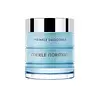What's inside
What's inside
 Key Ingredients
Key Ingredients

 Benefits
Benefits

 Concerns
Concerns

 Ingredients Side-by-side
Ingredients Side-by-side

Water
Skin ConditioningCyclopentasiloxane
EmollientIsodecyl Neopentanoate
EmollientHydrogenated Polyisobutene
EmollientGlycerin
HumectantButylene Glycol
HumectantIsohexadecane
EmollientStearic Acid
CleansingCetyl Alcohol
EmollientNylon-12
Glyceryl Stearate
EmollientStearyl Alcohol
EmollientDimethicone
EmollientGlyceryl Polymethacrylate
Acetyl Hexapeptide-8
HumectantPalmitoyl Tripeptide-1
Skin ConditioningSerine
MaskingGlycine
BufferingProline
Skin ConditioningPalmitoyl Carnitine
Skin ConditioningAlanine
MaskingGlutamic Acid
HumectantCamellia Sinensis Leaf Extract
AntimicrobialCalluna Vulgaris Flower Extract
Skin ConditioningCentella Asiatica Extract
CleansingRetinyl Palmitate
Skin ConditioningTocopheryl Acetate
AntioxidantAscorbyl Palmitate
AntioxidantPCA
HumectantPhospholipids
Skin ConditioningChamomilla Recutita Flower Extract
MaskingEchinacea Purpurea Extract
MoisturisingPEG-20 Stearate
EmulsifyingPEG-100 Stearate
Dimethicone Crosspolymer
Emulsion StabilisingBisabolol
MaskingAcrylates/C10-30 Alkyl Acrylate Crosspolymer
Emulsion StabilisingXanthan Gum
EmulsifyingEthoxydiglycol
HumectantLecithin
EmollientGlucose
HumectantLactic Acid
BufferingTriethanolamine
BufferingPropylene Glycol
HumectantDisodium EDTA
Phenoxyethanol
PreservativeDiazolidinyl Urea
PreservativeWater, Cyclopentasiloxane, Isodecyl Neopentanoate, Hydrogenated Polyisobutene, Glycerin, Butylene Glycol, Isohexadecane, Stearic Acid, Cetyl Alcohol, Nylon-12, Glyceryl Stearate, Stearyl Alcohol, Dimethicone, Glyceryl Polymethacrylate, Acetyl Hexapeptide-8, Palmitoyl Tripeptide-1, Serine, Glycine, Proline, Palmitoyl Carnitine, Alanine, Glutamic Acid, Camellia Sinensis Leaf Extract, Calluna Vulgaris Flower Extract, Centella Asiatica Extract, Retinyl Palmitate, Tocopheryl Acetate, Ascorbyl Palmitate, PCA, Phospholipids, Chamomilla Recutita Flower Extract, Echinacea Purpurea Extract, PEG-20 Stearate, PEG-100 Stearate, Dimethicone Crosspolymer, Bisabolol, Acrylates/C10-30 Alkyl Acrylate Crosspolymer, Xanthan Gum, Ethoxydiglycol, Lecithin, Glucose, Lactic Acid, Triethanolamine, Propylene Glycol, Disodium EDTA, Phenoxyethanol, Diazolidinyl Urea
Ingredients Explained
These ingredients are found in both products.
Ingredients higher up in an ingredient list are typically present in a larger amount.
Camellia Sinensis Leaf Extract is derived from the leaves of the tea plant. Black tea, green tea, and oolong tea are all harvested from this plant.
This ingredient has many skin benefits:
This ingredient contains polyphenols, a strong antioxidant. Antioxidants help fight off molecules that damage skin cells.
On top of that, the antioxidants in green tea neutralize free-radicals from the sun. This gives the skin some extra UV protection, but should not replace sunscreen.
Many components of tea have anti-inflammatory properties.
Polyphenols and L-theanine help soothe the skin and reduce irritation. The caffeine in Camellia Sinensis Leaf Extract helps calm inflamed blood vessels.
Other compounds found in tea include: Vitamin Bs, linoleic acid, magnesium, calcium, iron, and zinc.
Research has shown both drinking Camellia Sinensis Leaf Tea and applying it to the skin can help boost skin elasticity and hydration. Studies also show using tea extract may reduce sebum, or oil, production.
Learn more about Camellia Sinensis Leaf ExtractPhenoxyethanol is a preservative that has germicide, antimicrobial, and aromatic properties. Studies show that phenoxyethanol can prevent microbial growth. By itself, it has a scent that is similar to that of a rose.
It's often used in formulations along with Caprylyl Glycol to preserve the shelf life of products.
Propylene Glycol is an odorless, colorless liquid. As a humectant, it helps skin retain moisture. It also aids in delivering active ingredients.
Another role of this ingredient is preventing a product from melting or freezing. Propylene glycol also adds antimicrobrial properties to a product, elongating product lifespan.
This ingredient is considered an organic alcohol and commonly added into both cosmetics and foods.
Those with sensitive skin or conditions may develop a rash when using this ingredient.
Learn more about Propylene GlycolWater. It's the most common cosmetic ingredient of all. You'll usually see it at the top of ingredient lists, meaning that it makes up the largest part of the product.
So why is it so popular? Water most often acts as a solvent - this means that it helps dissolve other ingredients into the formulation.
You'll also recognize water as that liquid we all need to stay alive. If you see this, drink a glass of water. Stay hydrated!
Learn more about Water